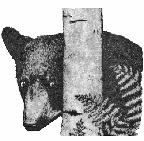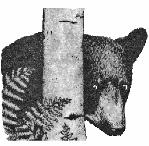The Florida Wildlife Commission (FWC) claims that the Central Bear Management Units (BMUs) had about
1000 bears in 2002 and 1300 in 2014 (Table 1), a 30% increase. FWC claims that there are now 550
bears in the North BMU (Table 1); but I don’t have figures for their abundance in 2002. For the sake of
argument, let’s assume that the FWC is right and that bear abundance in the North has more than
doubled. Assume 220 bears there in 2002. That would be an increase from 1220 in 2002 to 1850 in 2014
for the Central and North BMUs combined. That’s a gain of 630 (51.5%) bears over 12 years = 52.5
bears/yr (4.3%/yr as an arithmetic average and 3.5%/yr as a geometric average – as for compound interest
on a bank account).
Table 1: FWC’s figures for each huntable BMU. This assumes that each BMU subpopulation could grow at
20%/yr if there were no human-caused mortality, and that subtracting out the number of bears lost to non-
hunting human-caused mortality, yields the balance that could be harvested by hunters and thereby
stabilize population size.
________________________________________________________________________________
20% of Average
BMU Population Population Known Harvest %
(Yr of Population Estimate) Estimate Estimate Mortality Objective Harvest
East Panhandle (2002) 600 120 80 40 6.7%
North (2014) 550 110 10 100 18.2%
Central (2014) 1300 260 160 100 7.7%
South (2002)* 700 140 20 80 11.4%
North + Central (2014) 1850 370 170 200 10.8%
All 4 Huntable BMUs 3150 630 270 320 10.2%
________________________________________________________________________________
Information in blue font added by me
* Figures for the South BMU exclude Big Cypress since it won't be hunted in 2015.
This 3.5%/yr would be the maximum percent of the North+Central BMU population that could be harvested
each year without reducing post-hunt size of the population. This is like a savings account that earns 3.5%
/yr interest. If you leave all of the interest in the account, then it keeps compounding year after year: If you
had started off with $1220 at the end 2002, you would have had $1263 by the end of 2003, $1307 by the
end of 2004, … 1844 by the end of 2014, and 1908 by the end of 2015. If you left the accumulated
interest in the account for another year, you would have $1975 by 2016. (Table 2)
Table 2. Potential growth of the North & Central BMU subpopulations [or bank accounts] at various rates:
3.5%/yr which I calculate from FWC figures, and at the 11%/yr which FWC calculates based on an assumed
potential rate of 20%/yr if there were no human-caused mortality.
______________________________
__Annual growth rate___
3.5% 11% 20%
Year Estimated Population Size
2002 1220 1220 1220
2003 1263 1354 1464
2004 1307 1503 1757
2005 1353 1669 2108
2006 1400 1852 2530
2007 1449 2056 3036
2008 1500 2282 3643
2009 1552 2533 4371
2010 1607 2812 5246
2011 1663 3121 6295
2012 1721 3464 7554
2013 1781 3845 9065
2014 1844 4268 10878
2015 1908 4738 13053
2016 1975 5259 15664
______________________________
Now suppose that you give this account to an elderly aunt, telling her that if she takes out $64 (3.5%/yr)
this October and each October from now on, that size of the account will stabilize at $1908 by October of
each year just before withdrawal, and $1844 after withdrawal. But then some friend of hers convinces her
that she can actually withdraw $200/yr. If she doesn’t actually pay attention to her bank statements, and
just keeps spending $200/yr, she could get away with that for 6 years, but would go broke in the 7th year.
(Table 3).
Table 3. Potential decline of a population [or bank account] which can grow at 3.5%/yr, but which is being
harvested at 200 bears/yr [or $200/yr], based on the assumption that it can withstand 11%/yr harvest.
_______________________
Estimated Population Size
_______Pre-hunt Post-hunt
2015 1908 1708
2016 1768 1468
2017 1519 1219
2018 1262 962
2019 995 695
2020 720 420
2021 435 135
2022 139 0
_______________________
That’s equivalent to FWC claiming that it can harvest 200 bears/yr from the North+Central BMUs –
potentially year after year, based on the erroneous belief that the growth rate for these two BMUs is not
3.5%/yr but 11%/yr (Table 3).
Unlike a bank, Nature doesn’t send you a balance statement at least once each year. You have to go out
and do a new census to know whether the population has grown or shrunk each year. FWC has given no
indication that a new census is planned within the foreseeable future. So over-harvesting a BMU
subpopulation might not be detectable until the population is crashing. If FWC’s own figures for growth of
these 2 BMUs is valid, then harvesting 200 bears/yr, on average, would tend to halve the North+Central
subpopulation by 2018.
The FWC might, of course, argue that if any subpopulation was shrinking so rapidly, this would be reflected
in a decline in hunter success rate (percent of hunters who kill a bear each year). However, hunter
success rate can vary greatly due to several factors such as length of the hunt, number of hunters per day,
and weather. So 3-4 years might pass before FWC could be sure that there was a consistent and severe
decline in hunter success rate – by which time the population could be reduced by half.
| Blowing the Whistle About Over-Harvest of The Florida Black Bear Population! by Stephen F. Stringham, PhD |
| WildWatch "Making good conservation good business" [email protected] Ph/Fax (907) 260-9059 (Office) 39200 Alma Ave. Soldotna, AK 99669 |












